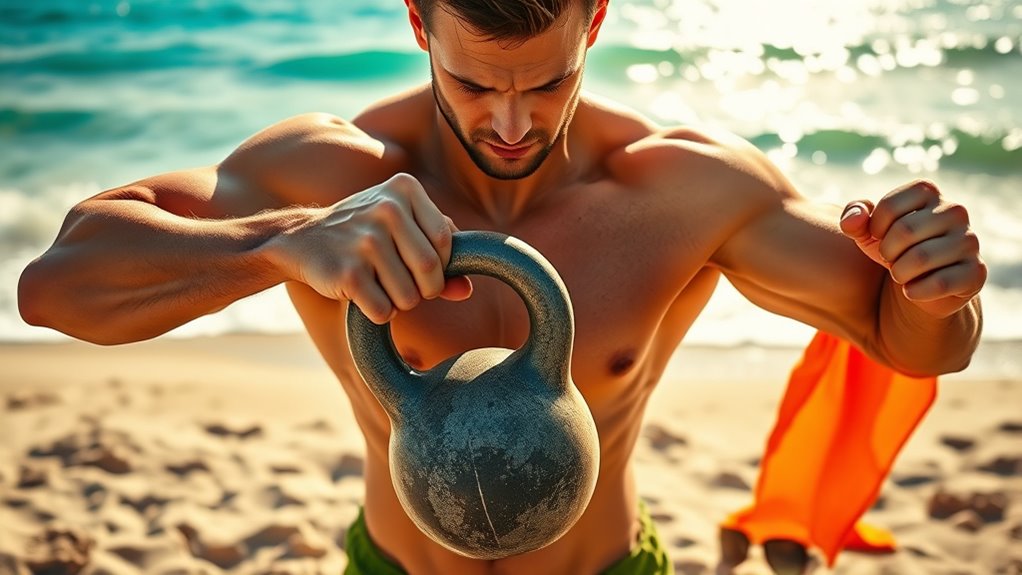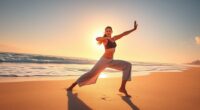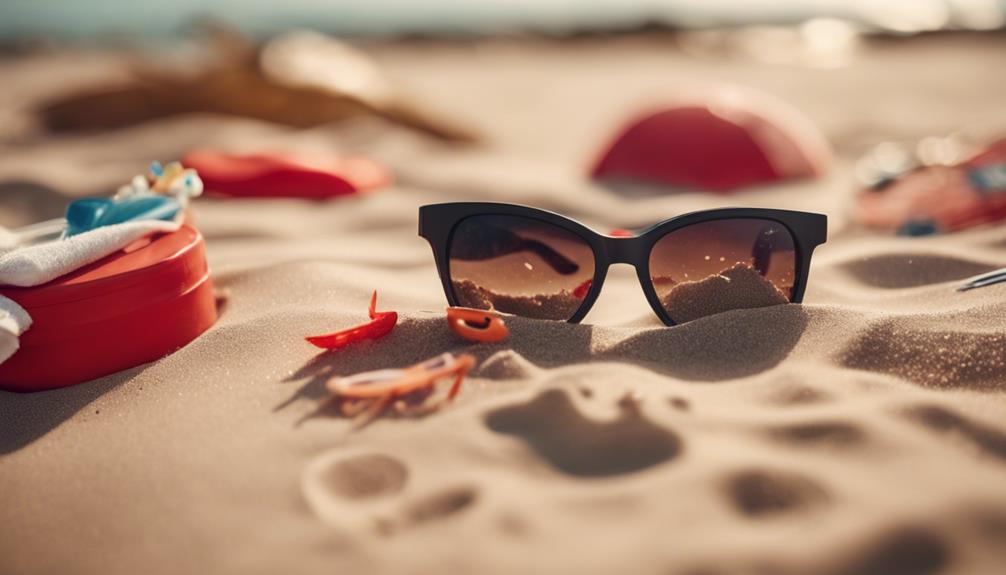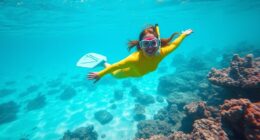To excel as a beach athlete, focus on core stability, balance, and flexibility through dynamic stretches and mobility drills. Incorporate plyometric exercises like box jumps and burpees to develop explosive power. Strengthen your lower body with squats and lunges, and your upper body with push-ups and pull-ups to boost endurance. Prioritize shoulder stability and arm strength for better control and injury prevention. Keep a consistent, progressive routine, and discover how proper training boosts your performance further.
Key Takeaways
- Focus on core stability, balance, and flexibility through dynamic stretching and mobility exercises to enhance movement control on sand.
- Incorporate plyometric exercises like box jumps and burpees to develop explosive power for jumping and quick movements.
- Strengthen lower body muscles such as glutes, quads, and hamstrings to improve mobility, stability, and endurance during beach activities.
- Build upper body strength and shoulder stability with targeted exercises like push-ups, pull-ups, and face pulls to support dynamic movements.
- Develop a consistent, progressive routine that gradually increases intensity, tracks progress, and emphasizes proper technique for safety and optimal gains.
Focus on Core Stability and Balance

Since core stability and balance are essential for beach athletes to perform at their best, focusing on these areas can markedly enhance your overall strength and agility. A strong core keeps your body aligned, improves posture, and reduces injury risk during quick directional changes or jumps. Incorporate exercises like planks, Russian twists, and leg raises into your routine to target your abdominal and lower back muscles. Balance training, such as single-leg stands or stability ball workouts, challenges your proprioception and coordination. Consistently practicing these movements helps you develop better control over your body, allowing for more precise movements on the sand. Prioritizing core and balance work not only boosts your athletic performance but also lays a solid foundation for all other strength exercises. To create a balanced workout, consider integrating functional movements that mimic real-world athletic actions. Additionally, incorporating mindfulness techniques, such as focused breathing or visualization, can improve concentration and mental resilience during training and competition. Engaging in targeted hybrid training methods can further optimize your strength and stability for beach sports. Incorporating eye patch benefits into your recovery routine might also help reduce eye strain and fatigue, supporting overall well-being during intensive training periods. Incorporating AI-powered training tools can provide personalized feedback and help track your progress more effectively.
Incorporate Plyometric Exercises for Power
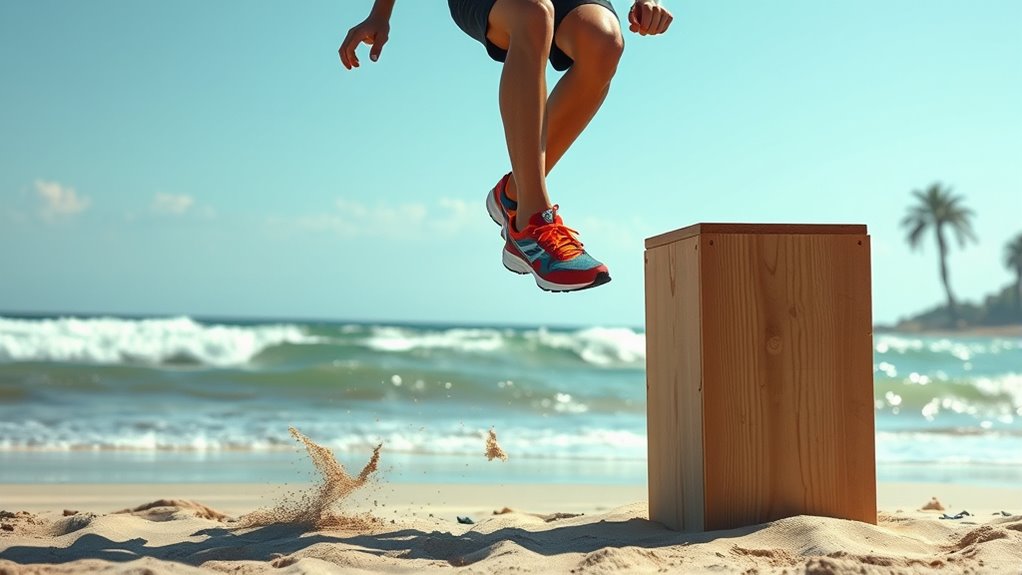
Plyometric exercises are crucial for building explosive power, which is pivotal for beach athletes to jump higher, sprint faster, and change directions quickly. These exercises improve your fast-twitch muscle response, enhancing overall agility and performance. Incorporate movements like box jumps, burpees, and plyometric push-ups into your training. Consistency is key—start with low-intensity drills and gradually increase intensity and volume. Proper technique prevents injury and maximizes gains. To visualize the benefits, check out this quick overview:
| Exercise | Benefits | Tips |
|---|---|---|
| Box Jumps | Power, vertical leap | Land softly, knees bent |
| Burpees | Full-body explosiveness | Maintain core engagement |
| Jump Lunges | Leg strength, balance | Explode upward, control descent |
| Clap Push-ups | Upper body power | Push explosively, clap mid-air |
| Bounding | Sprinting speed | Use arms for momentum |
Additionally, understanding the importance of remote hackathons can inspire innovative ways to enhance training routines through virtual collaboration and access to global expertise. Recognizing the significance of color accuracy can also help athletes visualize their progress more effectively through detailed feedback and analysis. Incorporating proper nutrition can further optimize your performance and recovery, and maintaining hydration levels is essential for sustaining energy during intense training sessions.
Strengthen Your Lower Body for Better Mobility

Building a strong lower body enhances your overall mobility and athletic performance on the beach. When your legs are powerful and stable, you can move quickly, change direction easily, and maintain balance during activities like volleyball or running along the shoreline. To boost your lower body strength, focus on exercises that target your glutes, quads, hamstrings, and calves. Incorporate movements such as squats, lunges, step-ups, and deadlifts into your routine. These help develop muscle control and joint stability, reducing injury risk. Consistent training not only improves your ability to perform beach activities but also enhances your endurance for longer sessions. Strengthening your lower body is essential for staying agile, boosting confidence, and enjoying your time on the sand to the fullest. Additionally, understanding how weight of wind turbine blades can vary with design and materials highlights the importance of proper training and equipment selection for optimal performance. Regularly updating your workout plan and training techniques can further optimize your progress and prevent plateaus. Incorporating periodized training programs can help structure your workouts for consistent gains. A well-designed training plan can also incorporate leadership skills, such as setting goals and tracking progress, to keep motivation high and ensure steady improvement. Moreover, integrating musical therapy principles, like rhythmic movements, can enhance your workout consistency and enjoyment.
Target Your Upper Body for Endurance and Strength
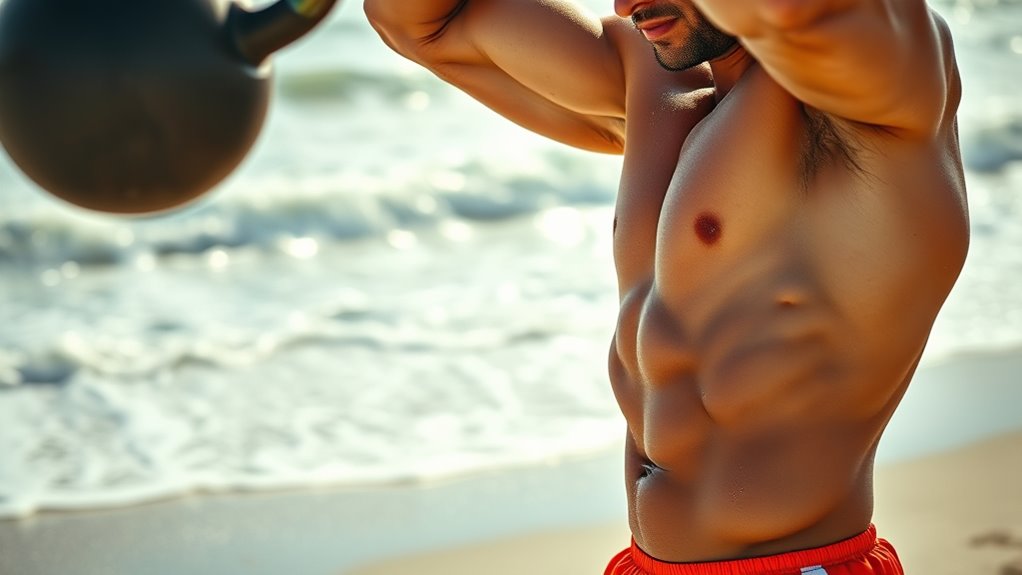
Focusing on your upper body will boost both endurance and strength needed for beach activities. You should work on enhancing shoulder stability to prevent injuries and improve control. Building arm power will help you generate more force for powerful movements and sustained performance. Additionally, incorporating automation technologies can streamline your training routines, making your workouts more efficient and adaptable to your progress. Utilizing proper training techniques based on a solid understanding of muscle function can further optimize your results. Paying attention to sleep and recovery is also essential, as adequate rest supports muscle repair and overall performance. Staying informed about current security trends can help you adapt your training strategies to new challenges and innovations in fitness tools.
Enhance Shoulder Stability
To boost shoulder stability, you need to incorporate targeted exercises that strengthen the muscles responsible for joint support. Focus on strengthening the rotator cuff and scapular stabilizers to prevent injuries and improve movement. Incorporate exercises like external rotations, scapular push-ups, and face pulls into your routine. These movements help activate deep shoulder muscles, enhancing endurance and control during dynamic activities. Consistency is key; perform these exercises 2-3 times a week for ideal results. Proper form is essential to avoid strain and maximize effectiveness. Over time, you’ll notice better shoulder stability, allowing you to lift, throw, and swim with greater confidence and reduced risk of injury. Strengthening these muscles creates a solid foundation for your upper body performance on the beach. Additionally, studying Bollywood Legends can inspire confidence and resilience, essential qualities for maintaining a consistent training regime.
Build Arm Power
Enhancing shoulder stability sets a strong foundation for developing arm power, enabling you to perform more explosive movements and sustain endurance during beach activities. To build arm strength, incorporate compound exercises like push-ups, pull-ups, and dips, which target multiple muscle groups simultaneously. Focus on progressive overload by gradually increasing resistance or repetitions, pushing your muscles beyond their comfort zone. Incorporate resistance training with dumbbells or resistance bands to add variety and challenge your muscles in different angles. Don’t neglect proper form—using correct technique maximizes effectiveness and prevents injury. Rest days are vital for recovery and muscle growth, so schedule them appropriately. Additionally, understanding muscle anatomy can help you target your training more effectively. Staying informed about AI security vulnerabilities can also guide you in choosing safer training equipment and avoiding potential technological pitfalls. Consistent training, combined with proper nutrition, will help you develop the arm strength needed to excel on the sand and perform powerful, sustained movements.
Prioritize Flexibility and Mobility Drills
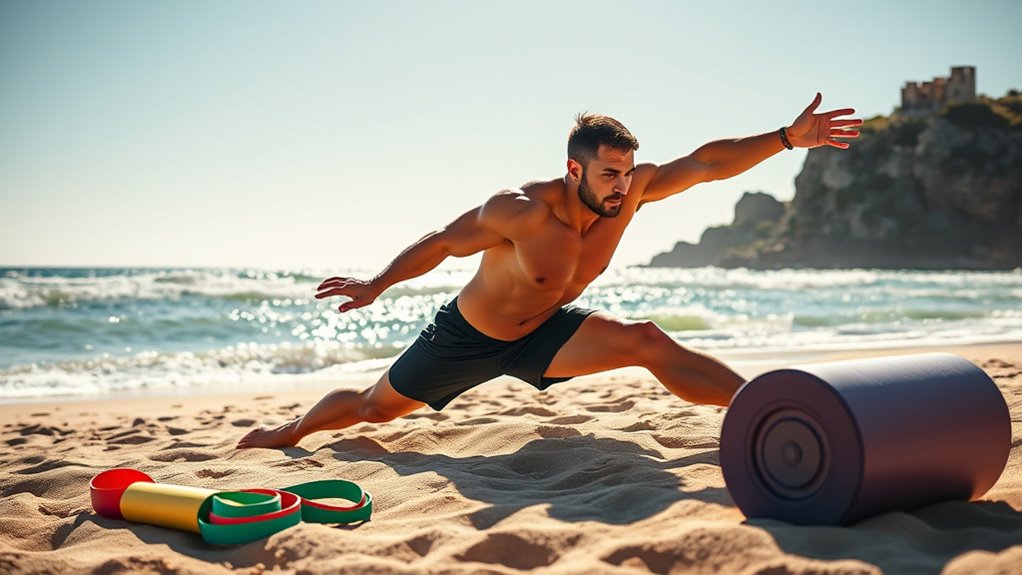
Incorporating dynamic stretching routines and active mobility exercises into your warm-up can substantially improve your flexibility. These drills prepare your muscles and joints for intense activity, reducing injury risk. Making them a regular part of your training helps you move more freely and perform at your best on the beach.
Dynamic Stretching Routines
Dynamic stretching routines are essential for beach athletes because they prepare your muscles and joints for intense activity. These stretches increase blood flow, improve range of motion, and reduce injury risk. Incorporate movements that mimic your sport to optimize performance. For example, leg swings loosen up your hips and hamstrings, while arm circles activate shoulder muscles. Walking lunges engage your legs and glutes, preparing you for jumping and quick directional changes. Incorporate these routines into your warm-up to elevate body temperature and enhance flexibility. Remember, dynamic stretches should be controlled and smooth, never bouncy or jerky. Consistently practicing these drills helps you move more freely and confidently on the sand. Keep your routines brief, focused, and tailored to your specific activity needs.
Active Mobility Exercises
After completing your dynamic stretching routines, focusing on active mobility exercises can further boost your flexibility and joint function. These exercises involve controlled, deliberate movements that take your joints through their full range of motion. Incorporate activities like hip circles, arm swings, leg swings, and torso twists to maintain and improve mobility. Moving actively through these motions helps lubricate your joints, enhances muscle coordination, and prevents stiffness. You should perform these drills regularly, ideally after your warm-up or between sets, to keep your muscles loose and ready for training. Remember, the goal is to maintain fluid, pain-free movement, which translates to better performance on the beach and reduces injury risk. Active mobility exercises are essential for keeping your body agile and resilient.
Develop a Consistent and Progressive Training Routine
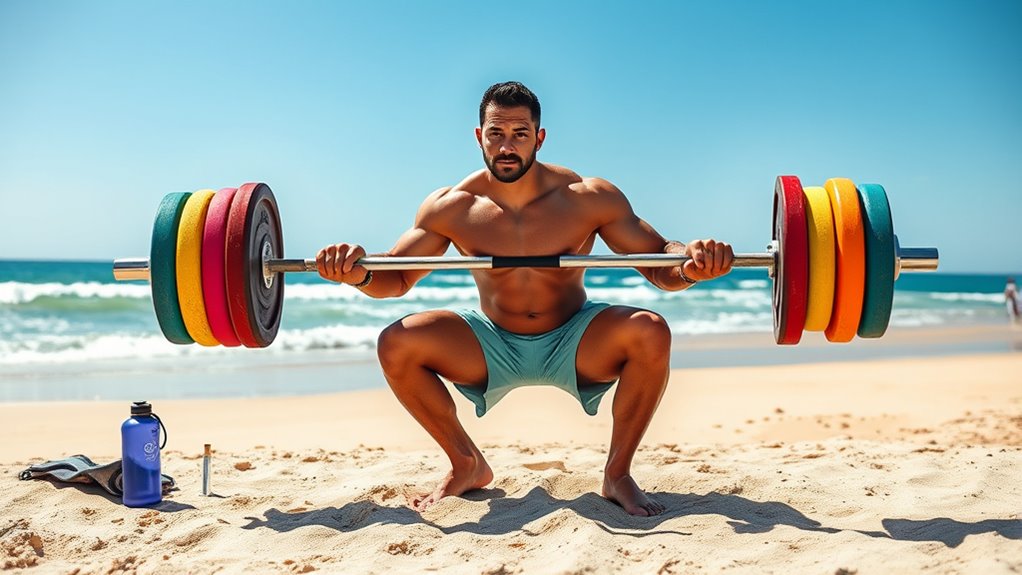
To see steady progress in your strength training, you need to establish a routine that’s both consistent and progressively challenging. This means working out regularly and gradually increasing the intensity or volume of your exercises. Consistency builds muscle memory and endurance, while progression ensures you avoid plateaus.
Consistent, progressively challenging routines are key to steady strength training progress.
Here are some key tips:
- Schedule workouts at the same time each week to build habit
- Track your reps, sets, and weights to monitor progress
- Gradually increase weights or repetitions every few sessions
- Vary exercises to target different muscle groups and prevent boredom
Frequently Asked Questions
How Often Should Beach Athletes Train for Optimal Strength?
You should aim to train for strength about three to four times a week, allowing your muscles time to recover and grow. Focus on a mix of resistance exercises targeting key muscle groups used in your sport. Incorporate rest days to prevent overtraining and injury. Consistency is key, so stick to your schedule, gradually increase intensity, and listen to your body to optimize your strength gains and performance on the beach.
What Nutrition Strategies Support Strength Training for Beach Athletes?
You should prioritize nutrition strategies that fuel your strength training effectively. Focus on consuming a balanced diet rich in lean proteins, healthy fats, and complex carbs to support muscle repair and energy levels. Stay hydrated and include electrolytes to prevent cramping. Timing meals around workouts with protein and carbs helps optimize recovery. Avoid processed foods, and listen to your body’s hunger cues to maintain consistent, performance-enhancing nutrition for beach training success.
How Can I Prevent Injuries During Intense Strength Workouts?
Think of your body as a finely tuned instrument; if you don’t tune it right, it risks cracking under pressure. To avoid injuries during intense workouts, warm up thoroughly to wake up your muscles, stay hydrated to keep everything flowing smoothly, and listen to your body’s signals. Use proper technique and don’t push past pain. These steps help you stay resilient and perform at your best without setbacks.
What Are the Best Recovery Methods After Strength Training Sessions?
After your strength training sessions, focus on proper recovery to prevent injuries and enhance performance. You should prioritize stretching to improve flexibility, hydrate well to replenish lost fluids, and eat a balanced meal rich in protein and carbs for muscle repair. Rest is vital—get enough sleep, and consider light activities like walking or swimming to promote blood flow. Incorporating foam rolling and massages also helps reduce soreness and speed up recovery.
How Do I Tailor Strength Routines for Different Beach Sports?
You should customize your strength routines based on the specific demands of each beach sport. For volleyball, focus on explosive power and agility, incorporating plyometrics and core exercises. For surfing, prioritize shoulder stability, balance, and upper body strength with targeted resistance training. Sand-based workouts can enhance endurance and leg strength. Adjust intensity and volume to match your skill level and sport-specific movements, ensuring you’re well-prepared for peak performance.
Conclusion
By incorporating these strength training tips, you’ll build a solid foundation that’s as sturdy as the beach’s sands. Focus on stability, power, and mobility, and watch your performance soar. Remember, consistency is your best wave—ride it with dedication and patience. With each workout, you’re sculpting a stronger, more resilient you, ready to conquer the sands and surf the waves of success. Keep pushing forward, and your beach game will shine brighter than the sun!

